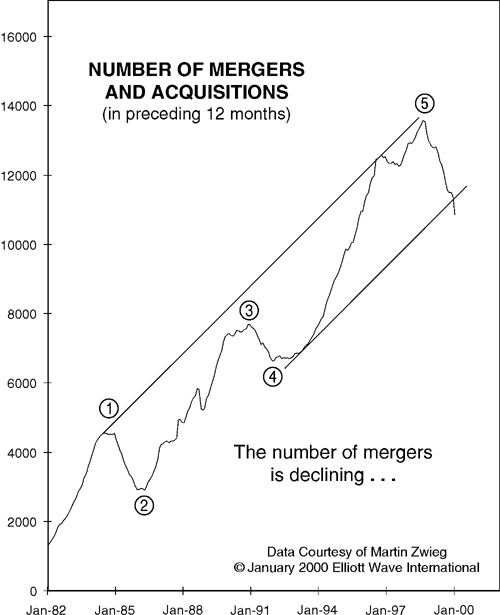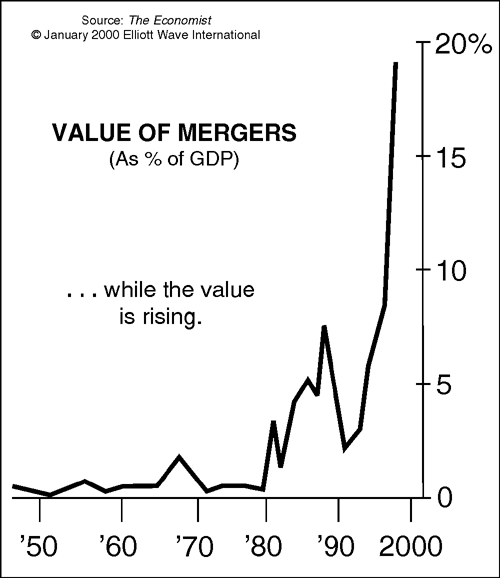Additional References
EWFF, July 2000
One way legal historians have quantified progress and regress in the U.S. antitrust movement is the amount of merger activity. As antitrust activity rises, many have documented an inverse relationship, in which mergers “disappear.” In our research for the May issue, we found data on mergers in a book on federal antitrust policy. [To view the charts click here.] The data for the most recent bull market [the fourth chart in the sequence] is updated from February issue of The Elliott Wave Financial Forecast. If you put each of these charts up against [the proliferation of antitrust suits in bear markets], you will see how beautifully they fill in the blank spots, i.e. the major bull markets. In light of this century-long correlation between the number of mergers and rising stock prices, another major confirmation of a reversal in social mood is a recent outbreak of anti-merger fever. Within the last few weeks, the U.S. authorities have blocked WorldCom’s purchase of Sprint, H.J. Heinz's purchase of BeechNut Nutrition and the $6 billion combination of the Burlington Northern Santa Fe and the Canadian National Railway, which would have been the biggest railroad combination in history. Several other deals that would have met with no resistance in the late 1980s and 1990s, including United Airlines’ buyout of US Air, AOL’s merger with Time Warner and Bell Atlantic’s bid for GTE, are now being challenged by various federal agencies.
The SEC and Federal Accounting Standards Board have undermined the potential for any more record breaking deals with an attack on the “pooling of interest” accounting method that has allowed countless firms to make acquisitions with their inflated stock rather than cash or debt. “During the topping and declining mood trend, all kinds of sociological forces work against corporations that are visibly successful,” EWT said in May. Support, cooperation and synthesis give way to divisiveness and resentment. In the last two months, the speed and scope of this social change has clearly accelerated. Once the judge threw the book at Microsoft, it was as if he had declared “open season” on mergers and cooperative business relationships. This massive social change in attitude is consistent with the transition to a bear market in stocks.
EWFF, February 2000
The Merger of the Century?
There are many reasons to suspect that the union of AOL and Time Warner will mark the end of the mergers and acquisition boom. The primary one is this chart of the number of announced deals.

It updates an earlier version that called for the completion of a fifth wave in At the Crest of the Tidal Wave. While the total number of deals has been falling for more than a year and a half, the value of mergers as a percentage of GDP has continued to climb rapidly, as the chart shows.

So, just like the overall stock market, merger activity has been divided into the broader market, which has been falling since the middle of 1998, and the total value of acquisitions, which has continued to accelerate on the strength of a few blockbuster deals. The decline through the lower trend channel on the number of deals, however, indicates that a bear market at all levels of the M&A business is near.
The euphoria surrounding AOL’s purchase of Time Warner may mark the top. As The Wall Street Journal put it, “The deal was heavy with superlatives and symbolism. It would be the biggest merger in history yahoo!” Even though it has a book value of just $3 billion, AOL’s inflated stock price allowed it to bid $156 billion for Time Warner. The price represented a record 70% premium over Time Warner’s pre-announcement market value. Business Week posted a picture of AOL’s leaders on its cover and declared them “Men of the Century.” The colossal expectation built into the merger is represented by the fact that the century was less than three weeks old at the time. As we noted last month and many times in the past, Business Week cover stories attesting to the strength of the long-term trend have a history of marking important peaks. Time magazine’s record is even more distinguished, so its corporate parent’s willingness to surrender control to an Internet upstart is indeed probably the “crowning” achievement of the new economy, as so many media outlets have asserted. Another signal of an imminent reversal in the bull market for mergers is the establishment of a new daily newspaper that will chronicle the M&A business “the same way Variety does for show business.”
More important, there is a broader message in this reversal. As At the Crest noted, one of the main ways “companies express optimism is by taking over other companies. …Such activity is indicative not of minor bull market tops, but of ones that precede prolonged and devastating bear markets.” As the chart shows, lower peaks in value as a percent of GDP anticipated downturns for stocks and the economy in the 1970s and the early 1990s.
|
